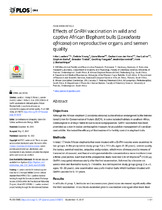| dc.contributor.author | Lueders, Imke | |
| dc.contributor.author | Young, Debbie | |
| dc.contributor.author | Maree, Liana | |
| dc.contributor.author | van der Horst, Gerhard | |
| dc.contributor.author | Luther, Ilse | |
| dc.date.accessioned | 2017-09-19T14:14:03Z | |
| dc.date.available | 2017-09-19T14:14:03Z | |
| dc.date.issued | 2017 | |
| dc.identifier.citation | Lueders, I. et al. (2017). Effects of GnRH vaccination in wild and captive African Elephant bulls (Loxodonta africana) on reproductive organs and semen quality. PLoS ONE
12(9): e0178270 | en_US |
| dc.identifier.issn | 1932-6203 | |
| dc.identifier.uri | https://doi.org/10.1371/journal.pone.0178270 | |
| dc.identifier.uri | http://hdl.handle.net/10566/3198 | |
| dc.description.abstract | OBJECTIVES:
Although the African elephant (Loxodonta africana) is classified as endangered by the International
Union for Conservation of Nature (IUCN), in some isolated habitats in southern Africa,
contraception is of major interest due to local overpopulation. GnRH vaccination has been
promoted as a non-invasive contraceptive measure for population management of overabundant
wildlife. We tested the efficacy of this treatment for fertility control in elephant bulls.
METHODS:
In total, 17 male African elephants that were treated with a GnRH vaccine were examined in
two groups. In the prospective study group 1 (n = 11 bulls, ages: 8±36 years), semen quality,
the testes, seminal vesicles, ampullae and prostate, which were all measured by means of
transrectal ultrasound, and faecal androgen metabolite concentrations were monitored over
a three-year period. Each bull in the prospective study received 5 ml of Improvac® (1000 μg
GnRH conjugate) intramuscularly after the first examination, followed by a booster six
weeks later and thereafter every 5±7 months. In a retrospective study group (group 2, n = 6,
ages: 19±33 years), one examination was performed on bulls which had been treated with
GnRH vaccine for 5±11 years.
RESULTS:
In all bulls of group 1, testicular and accessory sex gland sizes decreased significantly after
the third vaccination. In six males examined prior to vaccination and again after more than
five vaccinations, the testis size was reduced by 57.5%. Mean testicular height and length
decreased from 13.3 ± 2.6 cm x 15.2 ± 2.8 cm at the beginning to 7.6 ± 2.1 cm x 10.2 ± 1.8
cm at the end of the study. Post pubertal bulls (>9 years, n = 6) examined prior to vaccination
produced ejaculates with viable spermatozoa (volume: 8±175 ml, sperm concentration:
410-4000x106/ml, total motility: 0±90%), while after 5±8 injections, only 50% of these bulls
produced ejaculates with a small number of immotile spermatozoa. The ejaculates of group
2 bulls (vaccinated >8 times) were devoid of spermatozoa. Faecal androgen metabolite concentrations
measured in captive males decreased significantly after the fourth vaccination.
None of the males entered musth during the treatment period.
CONCLUSIONS:
Our results showed a marked decrease in semen quality, testicle and secondary sex gland
sizes following repeated GnRH vaccinations. After 2±4 years of continuous treatment every
5±7 months, the effects were similar to surgical castration. | |
| dc.language.iso | en | en_US |
| dc.publisher | Public Library of Science | en_US |
| dc.rights | © 2017 Lueders et al. This is an open access article distributed under the terms of the Creative Commons Attribution License, which permits unrestricted use, distribution, and
reproduction in any medium, provided the original author and source are credited. | |
| dc.subject | African elephant | en_US |
| dc.subject | Contraception | en_US |
| dc.subject | GnRH vaccination | en_US |
| dc.subject | Fertility control | en_US |
| dc.title | Effects of GnRH vaccination in wild and captive African Elephant bulls (Loxodonta africana) on reproductive organs and semen quality | en_US |
| dc.type | Article | en_US |
| dc.privacy.showsubmitter | FALSE | |
| dc.status.ispeerreviewed | TRUE | |
| dc.description.accreditation | ISI | |
| dc.description.accreditation | Scopus | |

